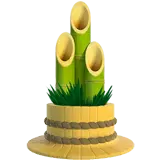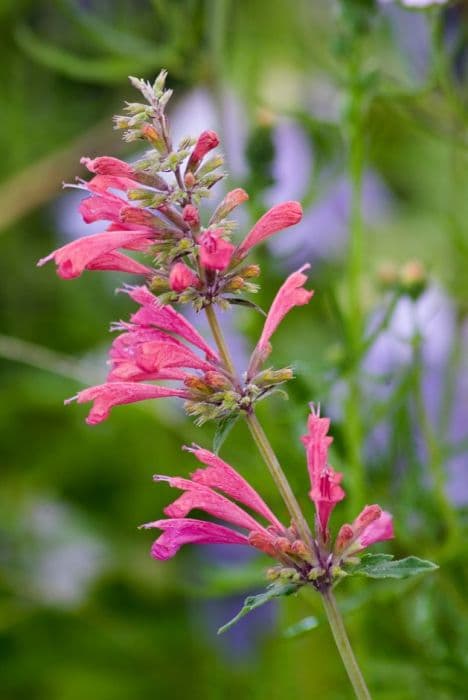Spanish Lavender Lavandula stoechas subsp. stoechas Lilac Wings = 'Prolil' (PBR)
![French lavender [Lilac Wings]](/_next/image?url=https%3A%2F%2Fplants-admin.emdemapps.com%2Fimages%2Fplants%2F%2Fimages%2F604b636b1d652.png&w=3840&q=75)
ABOUT
The plant known as French lavender 'Prolil', specifically the variety Lilac Wings, presents a lovely visual with its distinctly aromatic foliage and showy flower spikes. It features slender leaves that offer a gray-green color, creating a delightful contrast to the blooms. Resembling small wings, the flower heads are a charming lilac, with the top portion featuring darker, butterfly-like petals known as bracts, which add an ornamental value to the already attractive spikes. This French lavender variety stands out in gardens with its aromatic qualities and blooms that are both eye-catching and favored for their lengthy display from spring deep into the summer season. The overall form of 'Prolil' is dense and compact, making it an ideal choice for a variety of landscape uses without discussing its specific dimensions.
About this plant
 Names
NamesFamily
Lamiaceae.
Synonyms
French Lavender, Spanish Lavender, Butterfly Lavender, Top Lavender.
Common names
Lavandula stoechas subsp. stoechas Lilac Wings = 'Prolil' (PBR)
 Toxicity
ToxicityTo humans
Spanish lavender is not commonly known to be toxic to humans. However, ingesting large amounts of any lavender plant could potentially cause mild discomfort such as nausea or vomiting due to the natural oils and compounds found in the plant.
To pets
Spanish lavender is generally considered to be non-toxic to household pets such as cats and dogs. Nevertheless, if a pet ingests a large amount of the plant, it might experience mild gastrointestinal upset, which could include vomiting or diarrhea. It's always best to keep an eye on your pet and consult a veterinarian if any adverse reactions occur after ingesting plant material.
 Characteristics
CharacteristicsLife cycle
Perennials
Foliage type
Evergreen
Color of leaves
Green
Flower color
Purple
Height
2 feet (60 cm)
Spread
2 feet (60 cm)
Plant type
Shrub
Hardiness zones
8
Native area
Mediterranean
Benefits
 General Benefits
General Benefits- Aesthetic Appeal: Produces striking lilac-colored wings and flowers that enhance the visual appeal of gardens and landscapes.
- Perennial Growth: As a perennial, it survives multiple seasons, reducing the need for annual replanting.
- Drought Tolerance: Once established, it requires low water, making it suitable for xeriscaping and dry climates.
- Low Maintenance: Requires minimal care beyond occasional pruning and watering, saving time and effort for gardeners.
- Attracts Pollinators: Draws bees and butterflies to the garden, aiding in pollination of nearby plants.
- Suitable for Containers: Can be grown in pots or containers, ideal for patios or where garden space is limited.
- Fragrance: The leaves and flowers emit a pleasant fragrance that can create a relaxing atmosphere in outdoor spaces.
 Medical Properties
Medical Properties- Antiseptic: Lavender oil, which can be extracted from the Lavandula stoechas subsp. stoechas, has historically been used for its antiseptic properties.
- Anti-inflammatory: The plant may contain compounds that help reduce inflammation.
- Analgesic: Lavender is sometimes used for its pain-relieving effects.
- Antispasmodic: Lavender has been employed to relieve muscular spasms and cramps.
- Anxiolytic: The scent of lavender is well-known for its potential to alleviate anxiety and promote relaxation.
- Antimicrobial: Lavender oil has been studied for its ability to combat certain bacteria and fungi.
- Sedative: The plant has been used in herbal medicine to help induce sleep and calm nerves.
 Air-purifying Qualities
Air-purifying QualitiesThis plant is not specifically known for air purifying qualities.
 Other Uses
Other Uses- Companion Planting: Lavender can be used in gardens to help repel pests such as moths, slugs, and deer, due to its strong fragrance.
- Natural Dye: The flowers of the Lavender plant can be used to produce a natural dye for fabrics, yielding shades of blue, violet, or green depending on the mordant used.
- Craft Material: Dried Lavender stems and flowers can be incorporated into crafts, including wreaths, arrangements, and potpourri for their pleasant scent and aesthetic.
- Flavoring Agent: Lavender flowers can be used in cooking to add a distinctive floral flavor to baked goods, such as cookies and cakes, as well as to flavor honey, jams, or beverages like tea.
- Moth Repellent: Dried Lavender can be used in closets and drawers as a natural moth repellent to protect clothing and linen.
- Wedding Confetti: Dried Lavender buds can be used as biodegradable and fragrant wedding confetti as an alternative to rice or paper confetti.
- Photography Prop: Fresh or dried Lavender can be used as a prop in photography to add color, texture, and a sense of calm to the composition of photos.
- Footpath Liner: Lavender plants can line garden footpaths, releasing their scent when brushed against, which creates a fragrant walkway experience.
- Wool Protector: Lavender can be placed in bags with stored woolen items to deter clothes moths and keep the wool smelling fresh.
- Aromatherapy Material: The essential oil obtained from Lavender is widely used in aromatherapy for promoting relaxation and improving sleep quality.
Interesting Facts
 Feng Shui
Feng ShuiLavender is used in Feng Shui to bring a sense of calm and tranquility to a space. It's often recommended to place potted lavender or sprigs in areas where relaxation or meditation occurs, such as bedrooms or personal retreats. Its scent and energy are said to promote peace, restful sleep, and reduce stress.
 Zodiac Sign Compitability
Zodiac Sign CompitabilityLavender is not used in astrology practice.
 Plant Symbolism
Plant Symbolism- Calmness: The lavender plant is often associated with tranquility and calmness due to its soothing scent, which is widely used in aromatherapy to help reduce stress and anxiety.
- Purity: Its clean and fresh fragrance conveys a sense of purity, often symbolizing cleanliness and innocence.
- Devotion: Lavender can represent devotion and unwavering affection, sometimes used in bouquets to signify a committed, loving bond.
- Silence: Historically, lavender was believed to represent silence, likely due to its calming qualities that invite contemplation and peace.
- Healing: Recognized for its medicinal properties, the lavender plant symbolizes healing and restoration of the body and mind.
- Protection: In some cultures, lavender is thought to bring protection, often hung in homes to safeguard against evil spirits or misfortune.
- Serenity: Alongside its calming effects, lavender embodies serenity and is often associated with peaceful environments and a stress-free mindset.
 Water
WaterSpanish lavender should be watered deeply and infrequently, allowing the soil to dry out between waterings. Typically, this means offering water once every 1-2 weeks, depending on your climate and the season. Use a slow watering method to ensure deep penetration, which might equate to approximately 1-2 gallons for an established plant every couple of weeks during the growing season. Adjust the amount and frequency based on rainfall and temperature, as plants need less water in cooler, wetter conditions.
 Light
LightSpanish lavender thrives in full sunlight, requiring at least 6 to 8 hours of direct sun exposure daily. Plant in a location where it receives unobstructed sunlight for most of the day. These plants are adapted to bright conditions and may become leggy or produce fewer flowers if light is insufficient.
 Temperature
TemperatureSpanish lavender prefers a warm and temperate climate, ideally between 60 to 70 degrees Fahrenheit, but can survive temperatures as low as 10 degrees Fahrenheit and as high as 90 degrees Fahrenheit. Avoid placing it in locations prone to frost, as it is sensitive to severe cold.
 Pruning
PruningPrune Spanish lavender in early spring or immediately after the first flowering to encourage a second bloom and maintain plant shape. Light pruning can be done throughout the growing season to remove spent flowers and keep the plant tidy.
 Cleaning
CleaningAs needed
 Soil
SoilThe best soil mix for French Lavender 'Lilac Wings' is well-draining, sandy or gravelly soil with some organic matter. Aim for a pH of 6.5 to 7.5.
 Repotting
RepottingFrench Lavender 'Lilac Wings' should be repotted every 1-2 years or when it outgrows its current pot.
 Humidity & Misting
Humidity & MistingFrench Lavender 'Lilac Wings' prefers low to moderate humidity levels and does well in a typical household environment.
 Suitable locations
Suitable locationsIndoor
Place in a sunny spot with good air circulation.
Outdoor
Full sun, shelter from strong winds, well-draining spot.
Hardiness zone
8-10 USDA.
 Life cycle
Life cycleThe life cycle of Lavandula stoechas subsp. stoechas Lilac Wings, commonly known as French Lavender 'Prolil', begins with germination, where the seeds sprout when conditions of temperature, moisture, and light are favorable. The seedlings then develop into juvenile plants, establishing a root system and true leaves. As the plants enter the vegetative stage, they form bushy growth with silver-green foliage and begin to produce the characteristic lavender fragrance. During the flowering phase, typically in late spring to early summer, French Lavender 'Prolil' produces dense spikes of lilac-purple flowers adorned with petal-like bracts at their tips. After pollination, which is often aided by bees and other insects, the plant sets seeds, completing the reproductive cycle. Seasonally, the plant experiences a period of dormancy, especially in cooler climates, where it conserves energy until favorable growth conditions return in the spring.
 Propogation
PropogationPropogation time
Spring
Lavandula stoechas subsp. stoechas Lilac Wings, commonly known as French lavender 'Prolil', is typically propagated by semi-ripe cuttings. This is the most popular method because it tends to be more reliable and faster than seed propagation. To propagate by cuttings, select healthy, non-flowering shoots in late summer. Cut a 3 to 4 inch (approximately 7.5 to 10 centimeters) piece from the parent plant, making sure there are several nodes on the cutting. Strip the lower leaves, dip the cut end in rooting hormone, and insert it into a well-draining soil mix. Keep the cutting moist but not waterlogged and provide a warm environment to encourage rooting. With proper care, roots should develop within a few weeks, after which the new French lavender 'Prolil' plants can be gradually acclimated and eventually transplanted into the garden.





![Bugle [Sugar Plum]](/_next/image?url=https%3A%2F%2Fplants-admin.emdemapps.com%2Fimages%2Fplants%2F%2Fimages%2F604b597956a55.png&w=640&q=75)
![Bugle [Princess Nadia]](/_next/image?url=https%3A%2F%2Fplants-admin.emdemapps.com%2Fimages%2Fplants%2F%2Fimages%2F604b5806e268c.png&w=640&q=75)


